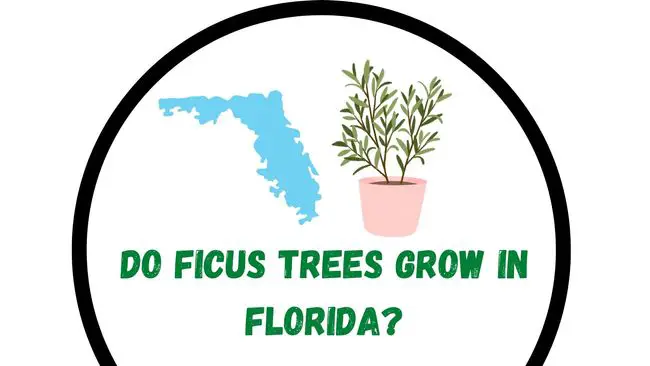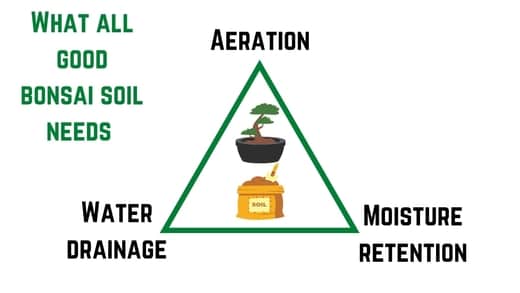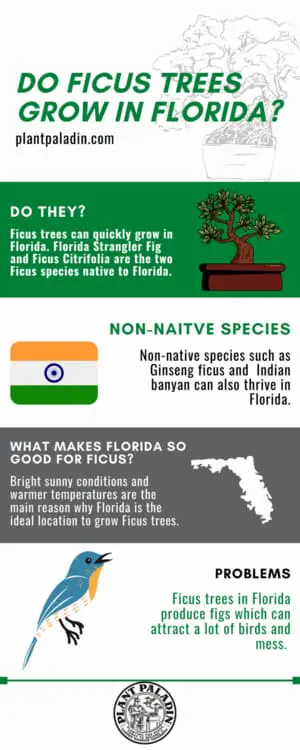This website is supported by its readers. If you click one of my links I may earn a commission. I am also a participant in the Amazon affiliates program and I will also earn a commission from qualified purchases.

One of the most popular trees grown indoors and outdoors are Ficus trees, commonly referred to as Fig trees. With Florida being the epicenter of several fruit trees, such as orange, lemon, and lime, this got me thinking, do Ficus trees grow in Florida?
Ficus trees can easily grow in Florida. Florida Strangler Fig and Ficus Citrifolia are the two Ficus species native to the US and are found only in Florida. Non-native species of Ficus such as Ginseng Ficus can also be grown quickly in Florida.
So what makes Florida so suitable for growing Ficus trees? And are there any special care tips you need to follow when growing Ficus trees in Florida? Keep reading to find out more!
Just a quick heads up, over the past three years of running Plantpaladin, hundreds of people have asked for product recommendations. As such, You can find my favorite indoor bonsai tree here (link takes you to Bonsaiboy), my favorite outdoor bonsai tree (link takes you to Bonsaiboy), or have a look at all the products I recommend here.
Do Ficus trees grow in Florida?
As many of you long-term blog readers know, I now have quite a few Ficus trees in my collection.
Most of these are native to Asia and used for bonsai.
I’ve recently noticed a lot of interest in Ficus trees that are more accessible globally.
With the majority of you reading this based in the USA, a common question I have received is if Ficus trees grow in Florida.
To get to the bottom of this, I reached out to a few experts, visited my local botanical gardens, and even did a quick survey of 5 plant paladin readers native to Florida.
Ensuring you have the best post possible on if Ficus trees grow in Florida.
To summerize:
- Ficus trees can be grown and cultivated in Florida and are relatively easy to care for if grown in Florida.
- The average temperatures of Florida are higher than most of the United States, matching the warmer Mediterranean and humid climates that make Ficus trees thrive.
- Florida is the only place in the US and north continental America where native Ficus trees grow.
- The native Ficus trees in Florida include the Ficus CItrifolia and the Strangler Fig.
- Other Fig//Ficus species can also be successfully grown in Florida, despite not being native to the country.
- These include the Fiddle leaf Fig, Ginseng Ficus, Ficus Microcarpa, and other Ficus trees that require warmer temperatures to thrive.
- While Ficus trees produce Figs, only common Figs should be grown as they do not require pollination.
Why do Ficus trees grow in Florida?
So now we know that Ficus trees do indeed grow in Florida; why does this happen?
After all, unlike other species such as Oak, Olive, Elm, or Juniper trees commonly found throughout the US, why is it that only Florida boasts native Fig trees?
In a word, it comes down to one thing – temperature.
Ficus/Fig trees, regardless of subspecies, need warmer temperatures to survive.
Typically anywhere from 60 degrees Fahrengigght to 100 degrees Fahrenheit.
As such, for most of us living in cooler climates, we can only really successfully grow Ficus trees indoors.
Not the case in Florida, where annual average temperatures regularly exceed 60 degrees.
Florida temperatures average between 60 degrees F and 80 degrees F year-round.
Even during the night.
The USDA recognized Florida as being in hardiness zones 8-11, the ideal lowest temperature possible for Ficus trees can be grown.
Sixty degrees F and above is the ideal temperature for native Ficus trees such as strangler Figs to grow outdoors naturally.
Florida matches up almost perfectly with the temperatures of any of the 800 or so sub-species of Ficus.
Ficus trees also require a lot of sunlight, usually around 6 hours of direct full sunlight in the summer.
Sunlight, too is something that the Florida state can uniquely provide.
Where in Florida do Ficus trees grow?
So, where exactly do native Ficus trees grow in Florida?
While there has not been a recent survey of the exact population of Ficus trees, according to Elbert Luthor, formally of the National Forestry Service, the vast majority of Florida strangler Fig trees are located in the south of Florida and the Florida Keys.
This is mainly due to the warmer climates and the humid air that can provide valuable nutrients and pollinate the trees efficiently.
Shortleaf Figs trees ( also known as Ficus Citrifolia) are commonly found in southern Florida, the Bahamas, Cuba, and other locations in northern central America.
Finally, Ficus trees, non-native to Florida, such as Ginseng Ficus, can also be grown quickly across the state while being kept outdoors.
However, the further south of Florida, the better the results will likely be.
Best cities to grow Ficus trees in Florida in?
Cities near the southern half of Florida and cities near the south coast of Florida will be the best cities to grow Ficus trees.
These include:
- Miami
- Fort Lauderdale
- Orlando
- Tampa
- Clearwater
- Cape coral
- Palm Bay
What are the most common Ficus trees that grow in Florida?
The two most common Ficus trees natively grown in Florida are the Florida Strangler Fig and the Florida Shortleaf Fig. Non-native Ficus trees such as Ginseng Ficus, fiddle leaf Fig, and Ficus Microcarpa can also easily be grown in the state.
How big do Ficus trees get in Florida?
Ficus trees grown outdoors, planted in the ground, and raised in their natural environment typically grow between 10 to 30 feet per year and can reach upwards of 50 to 100 feet.
Ficus trees native to Florida, such as Florida Stranglers and Shortleaf Figs, will only rarely reach 50 feet in height, and it is more commonplace for these Ficus sub-species to get between 25 to 40 feet.
To help explain more, the table below will go into how big Ficus trees can grow and how much you expect them to increase yearly.
Ficus Species | Growth rate | Average growth per year | Total height |
Ginseng Ficus | Slow | 1-5 inches per year | 70 inches |
Ficus Elastica | Fast | 10 to 15 feet | 100 feet |
Indian Banyan | Fast | 10 to 15 feet | 100 feet |
Fiddle Leaf Fig | Medium | 12 to 36 inches | 144 inches |
Chinese Banyan | Medium | 12 to 36 inches | 144 inches |
Red Leaf Fig | Medium | 12 to 36 inches | 144 inches |
Common Fig | Medium | 12 to 36 inches | 144 inches |
Moreton Bay Figs | Fast | 20 to 30 feet | 200 feet |
Fiddlelaf Fig | Medium | 12 to 36 inches | 144 inches |
Ficus Benjamina (Weeping Fig) | Medium | 12 to 36 inches | 144 inches |
How fast do Ficus trees grow in Florida?
Due to the warmer conditions, Ficus trees in Florida will typically grow at a medium to fast pace, averaging between 1 to 3 feet of growth per year. They will maintain this growth for a decade until the Ficus trees reach their max height of around 30 to 40 feet.
The only exception would be Ficus trees that are naturally smaller and slower growing and used for bonsai trees, such as ginseng Ficus, which typically only grow between 1 and 5 inches per year.
Other Ficus trees not native to Florida, such as the Indian Banyan Tree, will also not grow as tall or fast as they would naturally in the Indian subcontinent.
If you would like a Ficus tree that grows relatively quickly, stick to sub-species native to Florida, such as Florida strangler Fig and Ficus Citrifolia, or fast-growing Ficus species such as Ficus Nitidia.
Can you keep Ficus trees outdoors in Florida?
Without a doubt, the most significant benefit of growing Ficus/Fig trees in Florida is the fact that you can grow these trees outside.
Many of us, myself included, see Ficus trees as indoor plants, commonly used to purify the air and add a bit of freshness to our homes.
The main reason for this is that the vast majority of us live in climates that have temperatures regularly below 60 degrees F, sometimes even in the spring and summer.
Not the case in Florida, where temperatures are significantly warmer, meaning that Ficus trees, as well as other fruiting trees such as Orange, Lemon, and Lime trees, have no problem growing outdoors.
One of the biggest worries is keeping your Ficus trees outdoors in rainfall and overwatering.
After all, these trees are straightforward to care for and only need watering once per week when the topsoil is dry.
Despite being a wet state, Florida is also mostly sunny around 69% of the year, meaning that you won’t have to worry about mold or fungal infections growing on the trees.
Can you grow Ficus bonsai in Florida?
Alongside traditional Ficus trees, Ficus bonsai species such as Ginseng Ficus can also be successfully grown in Florida. The temperature conditions are perfect for growing this tree outdoors.
As the temperatures for Ficus bonsai species such as Ginseng Ficus match up perfectly with their native conditions, pruning, wiring, and repotting can all be undertaken as they would be in their native country or origin (China/Japan)
Problems with growing Ficus trees in Florida
So while we know now that you can successfully grow a Ficus tree in Florida, there are some downsides.
These include:
Can be invasive
So first, Ficus trees can be invasive.
More specifically, Ficus trees not native to Florida, such as fiddle leaf Fig or Ficus Microcarpa.
These trees can take over spaces such as parking lots, taking nutrients and vital resources away from native species.
A study by Caughlin et al. found that Ficus trees that produce a lot of Figs and attract many birds should be removed from specific areas in Florida to avoid an overabundance of invasive species.
Attraction of birds
Regardless of the species of Ficus, you may encounter another common problem: birds.
Ficus trees native to Florida typically reproduce without the need for Fig wasps.
If grown in the right conditions, they will frequently produce Figs.
With an abundance of the fruit comes birds that will try to feed on the Figs and potentially damage your Ficus tree and the surrounding environment.
Consider using scares to keep birds away from your Ficus if you have an extensive collection.
Leaf rust
Another problem all too common in Ficus trees is leaf rust.
A mold infection most commonly causes rust.
If left unchecked in some Ficus species, it can deteriorate your tree’s health, so I recommend using an excellent fungicide to treat the problem at its core.
For many of you reading this, however, rust will not impact your tree too much.
Ficus trees are semi-deciduous, meaning they will lose their leaves for a few weeks per year.
If you have a rust problem, but the overall health of your Ficus tree is OK, then leave the tree as its leaves will fall off and naturally grow back.
Best time to plant a Ficus tree in Florida?
Due to the warm conditions, Ficus trees can typically be planted year-round in Florida as the temperatures will exceed 60 degrees Fahrenheit.
The best time of year to plant Ficus trees will be in the late winter or early spring, ideally near the end of March, for best results.
The early spring will typically give your Ficus tree enough time to mature and prepare for the Fig fruits to be produced in July or August.
When to prune Ficus trees in Florida?
If planted in the ground, native Ficus trees can grow pretty big; as such, it’s important to note when the best time to prune Ficus trees during the year will be.
Spring and summer are the best times to prune Ficus trees in Florida. At this point, they will have less sap in the tree and lower energy levels meaning it will be easier to trim and prune the tree.
Pruning in spring and summer also gives your Ficus tree enough time to recover from any invasive cuts ensuring your Ficus tree heal before the dormant winter period.
How to plant a Ficus/Fig tree in Florida?
While this can be the topic for another post in itself, to summerise:
Decide if you want to plant in a pot or on the ground
One of the best things about the climate in Florida is that Ficus trees can be grown outdoors and indoors.
As such, one of the first decisions you should make is if you want to grow your Ficus in the ground or a pot.
Growing your Ficus in a pot, in the beginning, is what I would recommend. It just makes it easier to move and transport your tree around during the changing conditions.
If you would like your Ficus tree to grow larger and taller, then plating your Ficus in the ground, where it can get full sun, will be the way to go.
Apply a bottom layer of soil
Next up, add a bottom layer of soil for your Ficus tree.
The good thing about Ficus trees is that you can use both organic and inorganic soil mixes.
Ensure that your potting soil has good moisture retention aeration and water follow to prevent things like root rot or drought from occurring.

As such, dig a hole or gather a pot two times as deep as the root of your Ficus tree.
A hole this size will give them ample time to grow.
Then gently place your Ficus tree.
Secure your Ficus tree with wire if plating in a pot
If you are planting your Ficus tree in a pot, consider using wire to hold your tree together. Especially if you have a smaller Ficus species such as Ginseng Ficus.
Wiring will allow your Ficus tree the time it needs to adapt to its new environment.

An example of how you can thread the wire through the bottom of a pot
You won’t worry about it wilting over.
Consider also using techniques to help straighten your Ficus tree if you are worried about the tree growing at an odd angle.
Care for your Ficus tree
I recommend a few quick care tips once your Ficus has been planted.
First, repot your Ficus trees every two years or so in the first ten years of your Ficus trees’ life.
Repotting prevents your tree’s roots from growing more prominent or expansive than the space available.
Ensure you grow in the brightest spot in your garden where possible.
During cooler months, use an organic or inorganic mulch to add moisture and prevent drought in your tree.
Fertilize your ficus tree once a month during the summer months, or consider using coffee grounds a few times per year to add nutrients to your Ficus tree’s soil.
Finally, only water your Ficus when the topsoil of your tree is dry to touch.
This will prevent you from overwatering the tree.
Day-to-day care of any Ficus tree can be complex at first, but I find the care guidelines in the table below for Ginseng Ficus typically work best:
Day-to-day care of a ficus tree if you live in Florida
Ginseng Ficus Bonsai tree Requirements | Explained |
Water | Once per day in the spring-summer or if kept indoors. Once per week if kept outdoors during the winter. Only water if dry to touch. |
Sunlight | 4 hours of direct sunlight in the summer. LED grow light can also be used. |
Temperature | Between 60 degrees F and 100 degrees F |
Fertilizer | Fertilize 18 times per year, twice per month between spring and summer. Once per month in the fall and winter |
Repotting | Once every 2 to 3 years in the first 10 years. You can then report once every 5 years |
Placement | Can be placed outdoors in direct sunlight or indoors in a bright spot. |
Wire type | Both copper and aluminum wire can be used. |
Time to grow from scratch into maturity | 8 to 12 years to reach full maturity |
Potting soil | An inorganic Akdama, volcanic ash soil mix works best. |
Growth type | Slow growing, averaging 3-5 inches per year |
Size | Average store-bought trees are size is one or two-handed bonsai trees - 3 to 10 inches in size, 2 to 8 inches wide |
Lifespan | 50 to 150 years |
Fruit | figs |
Now, if somehow you have managed to kill your Ficus, check out my post on how to revive a dying ficus tree.
Are Ficus trees invasive in Florida?
Laurel Fig trees are designated a class 1 invasive species by the FLEPPC. The UF/IFAS Assessment also lists this species as a caution for growing in Florida and South Florida.
Native Ficus species such as Florida strangler Fig and Florida banyan Fig are not deemed invasive.
Does Florida have Fig wasps?
Florida does not have Fig wasps, meaning that Fig trees will be pollinated by hand or wind. Only common Figs are recommended for Florida as they can be pollinated without Fig wasps.
Can you grow non-native Ficus trees in Florida?
Non-native Ficus species can also be successfully grown in Florida very quickly. Florida has the proper sunlight and temperatures required for almost all Ficus sub-species.
What are the best Figs you can grow in Florida?
Common Figs are the best typed of Figs you can grow in Florida as they can be grown without the need for Fig wasps to pollinate them. Alternatively, Brown Turkey, Celeste, Jelly, and Green Ischia Figs can be raised successfully in northern and central Florida.
What is the best Ficus tree you can grow in Florida?
Florida strangler Fig and Ficus Citrifolia are the two best Ficus species you can grow in Florida. These species are native to Florida. Most other Ficus species, such as Ginseng Ficus, can quickly be grown in Florida.
I would, however, avoid invasive species such as Ficus Micrcarpa.
These can unearth the ground and cause significant damage to other flora ecosystems.
Survey results
Finally, I wanted to finish by asking five plant paladin readers who live in Florida if they successfully managed to grow a Ficus tree in their state.
To summerize:

Now, if you are reading this post and are interested in other content around ficus trees, check out the following:
My top picks for the gear you will need!
So like I mentioned earlier, over the past three years of running PlantPaladin, hundreds of people have asked me for my recommendations on the best bonsai gear on the market.
Having spent thousands of dollars on bonsai items these past few years and tested at least 100 bonsai-specific products, I’ve listed my favorite products below – All of which I highly recommend and think you can get great value.
They can purchase directly by clicking the link to take them to Amazon.
Bonsai Tool Set: One of the significant challenges I’ve had is finding a toolset that was not only durable but didn’t break the bank. SOLIGT has recently developed a fantastic bonsai tool set that covers all the tools you need to trim, prune, and repot your trees. – You can grab it here.
Complete Bonsai Set: Many of you will want to grow your bonsai trees entirely from scratch, but finding the varicose seeds, pots, and other items in one place can be challenging. Leaves and Sole then have created a complete bonsai set that I’ve personally used that ticks all the boxes. You can grab it here.
Bonsai wire: The number of times I’ve run out of wire for my bonsai or purchased cheap bonsai wire that doesn’t do the job is embarrassing for me to admit. After a lot of trial and error, I found that using Hotop’s aluminum bonsai wire is one of the best options on the market. This can easily be used for both indoor and outdoor bonsai. You can grab it here.
This post was written by Fehed Nicass who has been passionate about bonsai for over 3 years. He currently resides in the UK and works in sales.

